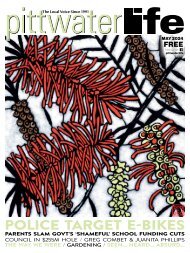Pittwater Life June 2022 Issue
- No tags were found...
Create successful ePaper yourself
Turn your PDF publications into a flip-book with our unique Google optimized e-Paper software.
Health & Wellbeing<br />
Health Special Feature<br />
Be migraine aware: it’s<br />
more than a headache<br />
It has been estimated 4.9 million Australians – one in five – are living<br />
with migraine. To mark International Migraine Awareness month, we’ve<br />
brought together information from the Brain Foundation and patient<br />
advocacy group Migraine Australia to help you understand more about<br />
this common and often debilitating disorder. By Lisa Offord<br />
What is migraine<br />
Migraine is a neurological disorder<br />
that is characterised by an<br />
intense one-sided throbbing or<br />
pulsating headache, which lasts<br />
between 4 and 72 hours with<br />
some warning symptoms (aura)<br />
before, and a ‘migraine hangover’<br />
(Postdrome) afterward.<br />
Migraine can be aggravated<br />
by physical activity and is very<br />
often associated with nausea<br />
and vomiting, as well as<br />
increased sensitivity to light,<br />
sound and even some types of<br />
smell.<br />
According to Migraine Australia,<br />
many people who live<br />
with migraine may not have a<br />
headache at all, and never know<br />
they have migraine. For others,<br />
migraine attacks are frequent<br />
and can be debilitating.<br />
Causes<br />
The exact cause of migraine<br />
remains a mystery; however recent<br />
research suggests strong<br />
genetic links.<br />
People with migraine often<br />
report that environmental<br />
factors such as diet, or the<br />
weather provoke or aggravate<br />
symptoms.<br />
The most reported food triggers<br />
are chocolate, cheese, coffee<br />
or other caffeinated drinks,<br />
nuts, citrus fruits, processed<br />
meats, additives, fatty or salty<br />
foods, and alcoholic drinks.<br />
Other triggers include bright<br />
or flickering light, motion,<br />
loud sounds, strong odours,<br />
changes in weather, fatigue or<br />
lack of sleep, stress, hormones,<br />
skipping meals and some<br />
medications.<br />
How to manage<br />
migraine<br />
Migraine cannot be cured but it<br />
can be managed by a combination<br />
of lifestyle changes,<br />
About aura<br />
A third of migraine patients<br />
experience ‘aura’ which is a<br />
range of neurological symptoms<br />
such as seeing lines, zigzag<br />
patterns, or a colourless<br />
‘hole’ in the vision, numbness<br />
and weakness, or dizziness,<br />
prior to the headache. Some<br />
people only have the aura<br />
symptoms and do not get<br />
headache.<br />
medications and tools that are<br />
right for you. Here are Migraine<br />
Australia’s top lifestyle tips.<br />
Establish a routine. At a minimum<br />
get up at the same time,<br />
eat at the same time and go to<br />
bed at the same time every day<br />
of the week. Getting a good<br />
night’s sleep is particularly<br />
important.<br />
Spread out your meals. Consider<br />
changing the way you eat<br />
to five or six small meals a day<br />
rather than three big ones. This<br />
will help keep your blood sugar<br />
consistent and may help reduce<br />
your attacks.<br />
Do an elimination diet. This<br />
is best done with a dietitian to<br />
help find any food triggers so<br />
you can avoid them.<br />
Keep a diary. Keep a diagnostic<br />
migraine diary for three months<br />
to help identify other triggers,<br />
such as stress or changes in<br />
the weather. For women, pay<br />
particular attention to your<br />
menstrual cycle: a migraine<br />
attack around ovulation and a<br />
day or two before your period<br />
is common.<br />
Stay active. Thirty minutes of<br />
light exercise, such as a walk<br />
or yoga, daily can be very<br />
beneficial however, high impact<br />
exercise can make migraine<br />
worse.<br />
Medications<br />
Acute treatments refer to<br />
medications used to treat a<br />
migraine attack at the onset<br />
of symptoms. These include<br />
simple pain relief medications<br />
you can buy over the counter<br />
in pharmacies or supermarkets<br />
or medications that can alter<br />
pressure on blood vessels, and<br />
anti-nausea medications.<br />
If you are experiencing more<br />
than three migraine attacks<br />
a month, Migraine Australia<br />
recommends you talk to your<br />
Simple tools to help manage<br />
migraine attacks and reduce<br />
symptoms include:<br />
n Having a sleep<br />
n Putting an ice pack on the<br />
back of the neck or head<br />
n Lying down in a dark, quiet,<br />
and cool room<br />
n Drinking a cold cola or strong<br />
coffee<br />
n Drinking a sports drink or<br />
eating salty food if craving salt<br />
n Taking a hot shower or using<br />
heat packs<br />
doctor about trying preventive<br />
medications, taken at regular<br />
intervals to reduce the incidence<br />
of attacks.<br />
Complementary<br />
therapies<br />
The Brain Foundation says the<br />
following therapies may also be<br />
used to further reduce migraine<br />
attacks.<br />
n Acupuncture: Stimulating<br />
acupoints may ease pain by<br />
encouraging production of endorphins<br />
(natural painkillers).<br />
n Alexander Technique: Can<br />
help prevent headaches by<br />
relieving poor posture and<br />
pressure that results from it.<br />
n Biofeedback: Patients learn<br />
to control blood pressure, heart<br />
rate, and spasms in the arteries<br />
supplying the brain through a<br />
sensory device.<br />
n Hypnotherapy: May help a<br />
patient cope with headache by<br />
altering the way the body interprets<br />
messages of pain.<br />
n Massage: Can reduce muscle<br />
tension throughout the body,<br />
thereby reducing headache.<br />
n Meditation: To relieve stress<br />
which is a major trigger for<br />
some migraine patients.<br />
Where to get help<br />
For most people, migraine can<br />
be managed effectively with the<br />
help of a GP without the need<br />
for specialists or tests.<br />
However, Migraine Australia<br />
recommends asking for a referral<br />
to a neurologist to confirm<br />
the diagnosis and says getting<br />
an MRI is a good idea if you<br />
have complex symptoms.<br />
Physiotherapy can be helpful<br />
and as migraine is commonly<br />
linked with anxiety and depression,<br />
having a psychologist<br />
as part of your care team is<br />
strongly recommended. Also,<br />
many people benefit from joining<br />
a support group.<br />
Health & Wellbeing<br />
50 JUNE <strong>2022</strong><br />
The Local Voice Since 1991<br />
The Local Voice Since 1991<br />
JUNE <strong>2022</strong> 51

















